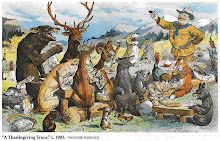By Brodie Farquhar
Late last month, U.S. District Court Judge Donald Molloy asked
attorneys for wildlife management agencies and environmental groups to
answer this question: Can the Northern Rockies wolf population still
be considered an "experimental" population, or has there been enough
cross-breeding with Canadian wolves to declare there's no danger of
genetic isolation or inbreeding?
The answer may be critically important, because the reintroduction of
wolves into Yellowstone National Park and central Idaho in the mid-90s
was predicated on the U.S. Fish and Wildlife Service calling those
wolves an "experimental, non-essential species."
This designation not only allowed wolves to be reintroduced to the
tri-state region of Wyoming, Idaho and Montana, it also gave the FWS
the flexibility to essentially consider the wolves a large-scale
experiment in reintroduction.
Without that designation as experimental, the wolves would have fallen under the full protection
of the Endangered Species Act and could not be so readily killed when they got into conflicts with livestock. (Great Lakes wolves are notexperimental and do occasionally attack and kill livestock, which doesprompt control measures.)
Molloy wrote that in the special rule published in March of 2010, FWS
noted it does not intend to reevaluate the "nonessential experimental"
designation given to the reintroduced wolves of the northern Rocky
Mountains. Instead, the service indicated it would not alter the 10(j)
status until the gray wolf of the northern Rocky Mountains is
recovered and delisted.
Citing relevant statutes, Judge Molloy said distinct populations can
only be considered "experimental when they are wholly separate
geographically from non-experimental populations of the same species."
Yet according to the service's own research and Dept. of Interior
attorneys, wrote Molloy, there has been documented dispersal and
genetic exchange between Northern Rockies wolves and Canadian wolves –
enough to raise the question of whether the 1,700-strong Northern
Rockies wolves are still so genetically isolated from the
12,000-strong population of Canadian wolves, as to retain the status
of "experimental."
Molloy has asked attorneys for both sides to prepare briefs (not to
exceed 2,500 words) by Feb. 22, to answer whether Northern Rockies
wolves are "experimental."Molloy's order, issued Jan. 28, emerged from a lawsuit filed in 2008
by environmental groups (Defenders of Wildlife, et al), objecting to
newly proposed rules, issued by the U.S. Fish and Wildlife Service,
which could make it easier to kill wolves so as to protect deer, elk
and moose herds.
That rule, no doubt, was prompted by widening concerns that herd
numbers are going down and the widespread perception by many hunters
that wolves are to blame. Trouble is, science doesn't pin all or even
most of the blame on wolves – not when there are other predators,
human hunting, drought and forage conditions to consider as well.
Interior attorneys have extrapolated from studies that wolves are
dispersing widely and breeding. Yet those studies could be attacked as
being fairly weak, rather than statistically robust. Just because a
few Idaho and Montana wolves have moved toward Canada and Canadian
wolves have dispersed down into Idaho and Montana, does that really
mean widespread genetic exchange? How much is enough? Do we have
enough data to answer that question?
Opposition to wolf reintroduction from the ranching community might
have been even more forceful had there been no experimental 10(j)
designation. While the environmental community might have preferred a
straightforward reintroduction with no caveats about the reintroduced
wolves being experimental, that designation was widely understood to
be a political compromise, designed to get wolf reintroduction off
dead center.
The implicit deal for ranchers is that wolves that attacked livestock
would be quickly killed. The implicit deal for the environmentalists
is that wolves would quickly spread into good habitat that had
abundant prey species and little opportunity or need to attack
livestock.
To a great degree, both the environmental groups and the wildlife
agencies (federal and state) would like to maintain the status quo,
because 10(j) does create flexibility in dealing with wolves that
attack livestock. If 10(j) goes away, so does the flexibility of
targeting individual wolves and packs, or of allowing wolf hunts to
draw down wolf numbers.
On the other hand, there may be those in the environmental community
who would like to have wolves under straight ESA protection, and
thereby have fewer losses to the guns of Wildlife Services or state
big-game hunters. It might be viewed as a triumph for reintroduction,
that Northern Rockies wolves now have genetic connectivity with their
Canadian relations, and that genetic isolation is no longer to be
feared.
And yet, that very triumph might set the stage for declaring the grey
wolf to be recovered, or well on its way to recovery, and no longer
needing ESA protections.It gets complicated when law gets mixed in with biology and ecology.
Add politics, and the complication factor grows by levels of
magnitude. There are bills afoot in state legislatures and in Congress
to turn wolf management over to the states and to strip wolves of ESA
protections (regardless of law or science).However the attorneys reply to Molloy's order on Feb. 22, thesemantics fight will only continue.
Brodie Farquhar is a natural resources freelance writer who has
covered the salmon wars of the Northwest, water controversies in
Colorado and Arizona and, for the past 10 years, the Greater
Yellowstone Ecosystem in the Northern Rockies. His home is in Casper,
Wyoming.
Subscribe via email to get updates
Wednesday, February 16, 2011
What’s Behind Judge Molloy’s Questioning of ‘Experimental’ Status for Wolves? Molloy has asked attorneys for wildlife management agencies and the environmental groups that have sued them to prepare briefs by Feb. 22. .......Is the Judge trying to stop Ranchers from shooting wolves that kill livestock or is he seeking to expedite wolves off of the Endangered Species Act?......A revealing NEW WEST analysis for you to digest
Subscribe to:
Post Comments (Atom)










No comments:
Post a Comment